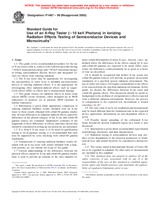Potrebujeme váš súhlas na využitie jednotlivých dát, aby sa vám okrem iného mohli ukazovať informácie týkajúce sa vašich záujmov. Súhlas udelíte kliknutím na tlačidlo „OK“.
ASTM F1467-99(2005)
Standard Guide for Use of an X-Ray Tester ([approximate]10 keV Photons) in Ionizing Radiation Effects Testing of Semiconductor Devices and Microcircuits
Automaticky preložený názov:
Štandardné sprievodca pre použitie X - Ray Tester ( [ priblížiť ] 10 keV Fotóny ) v ionizujúceho žiarenia efekty Testovanie polovodičových prvkov a mikroobvody
NORMA vydaná dňa 1.1.2005
Informácie o norme:
Označenie normy: ASTM F1467-99(2005)
Poznámka: NEPLATNÁ
Dátum vydania normy: 1.1.2005
Kód tovaru: NS-50397
Počet strán: 18
Približná hmotnosť: 54 g (0.12 libier)
Krajina: Americká technická norma
Kategória: Technické normy ASTM
Anotácia textu normy ASTM F1467-99(2005) :
Keywords:
Collimator, Electrical conductors-semiconductors, Electronic hardness, Experimental design, Hardness tests-radiation (of semiconductors), Ionizing radiation, Low energy ([aprox] 10 keV photons) X-ray sources, Microcircuits, Microelectronic device processing, Radiation effects testing, Radiation exposure-electronic components/devices, Radiation-hardness testing, Semiconductor device testing, X-ray testing, X-ray tester ([aprox] 10 keV photons)-ionizing radiation effects testing
Doplňujúce informácie
| 1. Scope | ||||||||||||||
|
1.1 This guide covers recommended procedures for the use of X-ray testers (that is, sources with a photon spectrum having [approximate]10 keV mean photon energy and [approximate]50 keV maximum energy) in testing semiconductor discrete devices and integrated circuits for effects from ionizing radiation. 1.2 The X-ray tester may be appropriate for investigating the susceptibility of wafer level or delidded microelectronic devices to ionizing radiation effects. It is not appropriate for investigating other radiation-induced effects such as single-event effects (SEE) or effects due to displacement damage. 1.3 This guide focuses on radiation effects in metal oxide silicon (MOS) circuit elements, either designed (as in MOS transistors) or parasitic (as in parasitic MOS elements in bipolar transistors). 1.4 Information is given about appropriate comparison of ionizing radiation hardness results obtained with an X-ray tester to those results obtained with cobalt-60 gamma irradiation. Several differences in radiation-induced effects caused by differences in the photon energies of the X-ray and cobalt-60 gamma sources are evaluated. Quantitative estimates of the magnitude of these differences in effects, and other factors that should be considered in setting up test protocols, are presented. 1.5 If a 10-keV X-ray tester is to be used for qualification testing or lot acceptance testing, it is recommended that such tests be supported by cross checking with cobalt-60 gamma irradiations. 1.6 Comparisons of ionizing radiation hardness results obtained with an X-ray tester with results obtained with a linac, with protons, etc. are outside the scope of this guide. 1.7 Current understanding of the differences between the physical effects caused by X-ray and cobalt-60 gamma irradiations is used to provide an estimate of the ratio (number-of-holes-cobalt-60/(number-of-holes-X-ray). Several cases are defined where the differences in the effects caused by X rays and cobalt-60 gammas are expected to be small. Other cases where the differences could potentially be as great as a factor of four are described. 1.8 It should be recognized that neither X-ray testers nor cobalt-60 gamma sources will provide, in general, an accurate simulation of a specified system radiation environment. The use of either test source will require extrapolation to the effects to be expected from the specified radiation environment. In this guide, we discuss the differences between X-ray tester and cobalt-60 gamma effects. This discussion should be useful as background to the problem of extrapolation to effects expected from a different radiation environment. However, the process of extrapolation to the expected real environment is treated elsewhere (1, 2). 1.9 The time scale of an X-ray irradiation and measurement may be much different than the irradiation time in the expected device application. Information on time-dependent effects is given. 1.10 Possible lateral spreading of the collimated X-ray beam beyond the desired irradiated region on a wafer is also discussed. 1.11 Information is given about recommended experimental methodology, dosimetry, and data interpretation. 1.12 Radiation testing of semiconductor devices may produce severe degradation of the electrical parameters of irradiated devices and should therefore be considered a destructive test. 1.13 This standard does not purport to address all of the safety concerns, if any, associated with its use. It is the responsibility of the user of this standard to establish appropriate safety and health practices and determine the applicability of regulatory limitations prior to use. |
||||||||||||||
| 2. Referenced Documents | ||||||||||||||
|
Odporúčame:
Aktualizácia technických noriem
Chcete mať istotu, že používate len platné technické normy?
Ponúkame Vám riešenie, ktoré Vám zaistí mesačný prehľad o aktuálnosti noriem, ktoré používate.
Chcete vedieť viac informácií ? Pozrite sa na túto stránku.




 Cookies
Cookies
